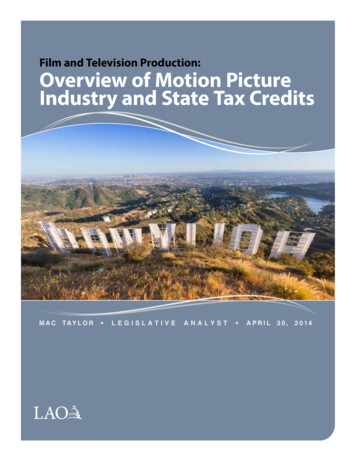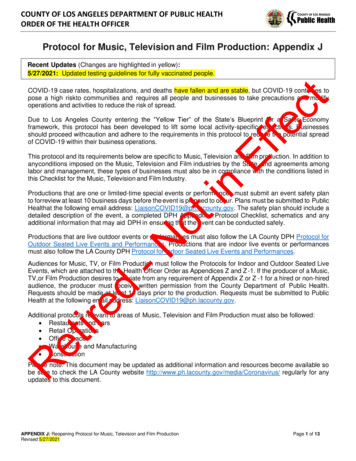
Transcription
FIREFLY FILM FACTORYA NEW FILMPRODUCTIONBUSINESSPLAN
FOR INFORMATION ONLYThis is a business plan for confidential use onlyand may not be reproduced, sold, or redistributedin any manner without prior consent fromPromotivate Studios.This business plan does not constitute an offer tosell, nor is it a solicitation or an offer to purchasesecurities. This business plan has been submittedon a confidential basis, solely for the benefit of aqualified investor, and is not for use by any otherpersons. By accepting delivery of this document,the recipient acknowledges and agrees that: (i) inthe event the recipient does not wish to pursuethis matter, the recipient will immediately andpermanently destroy all electronic copies,computer files, and correspondence containingthis plan; and (ii) the recipient will not copy, fax,reproduce, or distribute this plan, in whole or inpart, without permission; and (iii) all of theinformation contained herein will be treated asconfidential and cannot be shared with otherparties.
Promotivate Studios & Firefly Film Factory615 Lost Grove CircleWinter Garden, Florida, 34787USA omotivate.studios@gmail.comTag-lines and/or catch-phrases for Firefly Film Factory:“Follow The Light”“Lighting Your Way In The Dark”
TABLE OFCONTENTS1 / The Executive Summary2 / The Company3 / The Industry4 / The Market5 / Distribution6 / Risk Factors7 / The Financial Plan
CHAPTER 1THE EXECUTIVESUMMARYStrategic Opportunity North American movie box office revenues in 2019 were 11.32 billion Global box office revenues in 2018 were an all-time highof 41.7 billion In 2018, lower budget films turned risk-taking breakoutsinto global blockbusters: A Quiet Place, ( 17 millionbudget), The Nun ( 22 million budget) and Peter Rabbit( 50 million budget) each earned over 336 million inglobal box office sales The Coronavirus pandemic caused so many people toconsume film and Television content at an acceleratedpace that studios, networks, and streaming services aredesperately seeking new content to meet demand The film industry has historically prospered duringeconomic and global hardship as consumers turn towardescapism and motivational storytelling for inspiration
The CompanyFirefly Film Factory will be a high-concept, lower budget,feature filmmaking entity, engaged in the development andproduction of visually sumptuous, emotionally enthralling,and intellectually provocative movies for theatrical,television, and electronic distribution. This new film studiowill combine breathtaking imagery with powerful stories ofthe human spirit, alluring a mass audience with unique,timeless, and enlightening tales.The company plans to produce three films over the next sixyears with budgets ranging from 500,000 to 5 million.Management TeamThe company’s founders convey over thirty years ofsuccessful entrepreneurial experience and in-depthexpertise in motion picture development, production,exhibition, marketing, and sales. The team will becomplemented by a support group of creative andtechnical personnel from Hollywood and independentfilmmaking circles.The ProductWith compelling characters in adventurous and conflictedsituations, great movies have the power to stir the soul anddemonstrate to each of us that we are not alone in ourstruggles in this world. Through extensive ties with a newbreed of visual storytellers, Firefly Film Factory will deliveran initial slate of three feature films, nourishing the heartsand minds of audiences, providing abundant value andpositive, lasting, brand awareness.
Firefly Film Factory expects each film to stand on its ownand to produce profits that finance successive projects,strategically leveraging the Company as the world’s leadingindependent production Studio, with commerciallysuccessful films and artistic, award-winning accolades,driving further marketing and expansion efforts.The IndustryLow budget, independent film successes like Memento, aslick 4.5 million film that made 25.5 million, The UsualSuspects, budgeted at 4 million and earning 23 million, ElMariachi, a slender 7,000 project that managed 1.6million in domestic box office sales, and Sex, Lies, &Videotape, a 1.4 million film earning 24.7 million in itstheatrical release alone have demonstrated that little moneycan go a long way in the business of making movies. Bydefinition, an independent film is one that is financed byany source other than a major U.S. studio. Independentfilms vary widely in budget, generally from thirty thousandto several million dollars. Operating with minimal overheadexpense, independents spend more time developing richand fascinating characters in compelling and uniquesituations. Because of limited financial capacity,independents plan their budgets more carefully and oftenrealize higher profit ratios than major studios.The future for low-budget, independent films continues tolook impressive as their commercial viability has increasedsteadily over the last decade. The independent market as awhole has expanded dramatically in the past 15 years while
total domestic box office increased 45%. Proof of the highquality of “Indie” features is that an independent film wonthe Academy Award for Best Picture in 10 of the last 11 years.Widely recognized as a “recession-proof“ business, the filmindustry has historically prospered during periods ofdecreased discretionary income and during troubled times,as humans opt for escapism, motivation, and life-lessons. Infact, during the Coronavirus pandemic, entertainmentstreaming services experienced unprecedented demand asquarantined families voraciously consumed motion picturecontent. This dovetails perfectly with our productionstrategy as distribution opportunities now abound in therace to acquire more content to keep pace with significantdemand.For these reasons and more, it is an opportune time forequity investors to move into the independent film arena.Technology has dramatically changed the way films aremade, allowing independently financed films to look andsound as good as those made by Hollywood studios, whileremaining free of the creative restraints placed upon anindustry that is notorious for fearing risks and resistingforays into topics of a unique subject matter, where newopportunities abound.The MarketsAlthough Hollywood has a knack for visual spectacle andgrandeur, big budget movies sometimes fail to strike achord that resonates in the hearts and minds of audienceswhom not only crave escapism but also seek to enrich their
lives through educational and/or thought-provoking and/orspiritually-motivating entertainment.Independent production companies offer this morecomplex mix of art and entertainment. Not only haveindependents experienced impressive financial successover the past three years, they have also garnered moreOscar nominations than their Hollywood counterparts.As trends continue to modulate the face of theentertainment industry, now is the time to create acompany that offers a mix of all successful ingredients;substance and style, maintaining strategic and financialdominance throughout various market conditions.DistributionThe motion picture industry is highly competitive, withmuch of a film’s success depending on the skill of itsdistribution strategy.As an independent producer, Firefly Film Factory aims tonegotiate with major distributors for release of their films.Firefly Film Factory will seek partnerships with distributioncompanies that have proven their ability to handle lowerbudget films with sensitive themes and appeal to theCompany’s desire for special handling. We will holdscreenings for distributors in key market segments and fordistributors who possess specific experience in the genre ofa particular film. In addition, we will exhibit our movies atappropriate festivals.
As our reputation for quality filmmaking grows, bothdomestic and foreign markets will be anxious to buy ourproduct. Thus, Firefly Film Factory expects to garnerincreasing leverage in negotiating deals and attractingmajor cast and production elements.The production team is committed to making films that arehighly attractive products for theatrical distribution andother markets.Investment Opportunity & Financial HighlightsFirefly Film Factory seeks an equity investment of 15million for the development and production of three filmsover six years. Using a moderate revenue projection and anassumption of general industry distribution costs, weproject (but do not guarantee) a pretax investor net profit of 21 million.Alternatively, the Company will consider smaller offers frommultiple equity investors to reach this 15 million (total)goal, and will split revenues proportionally.
CHAPTER 2THE COMPANYStrategic ApproachFirefly Film Factory will be a privately owned companywhose principal purpose and business is the creation oftheatrical motion pictures and documentaries. TheCompany plans to develop and produce quality,inspirational films that stir thoughts and emotions throughcompelling stories, interesting characters, and visuallyalluring locations.The Company’s objectives are as follows:1) Produce films that celebrate unique facets of life andthe human spirit and are commercially viable for amass audience.2) Purchase and develop scripts with outside writers.3) Execute and exhibit three films within six years, withbudgets ranging from 500,000 to 5 million.4) Establish domestic and foreign distribution routes,negotiating deals with local, regional, national andinternational companies.5) Implement new technology, maximize utilization offilm crew, and streamline production routines thatreduce expenses.6) Design strategies for capital growth re-investmentopportunities.
Production Team (Management & Organization)The primary strength of any company is in its managementteam. The Company’s principles, Dustin Lee, Mike Hanly,and Aida Hernandez convey extensive experience inbusiness and in the entertainment industry. They alsoprovide a vast and potent network of key relationships withHollywood talent, business associates, and technical/creative personnel who will fill important roles on a projectby-project basis. The following individuals make up thecurrent management team:Mr. Dustin Lee, President and Executive ProducerMr. Lee possesses longstanding and wide-rangingexperience in filmmaking, corporate strategy, processengineering, and marketing. Mr. Lee reported directly totop-level executives within The Walt Disney Company,DreamWorks, Universal Studios, Paramount Pictures, AOL/Time Warner, Meridian Pictures Entertainment, and NextEntertainment as a business and creative strategist,providing his clients almost thirty years of experiencegenerating revenues in the billions of dollars. Guidingfinancial, technological, and artistic development withinthese companies, Mr. Lee played a major role in theimplementation of multi-million dollar films, theme parkattractions, and stage concepts. He produced, scripted,and directed content for film, television, commercial,documentary, Internet, and digital media. Hecommandeered script development, production,distribution, and release agendas. In addition, Mr. Leeresearched, developed, tested, and implemented marketing
campaigns associated with these projects. In all, he hasplayed a significant hand in the production of over 50 majorstudio and independent production features, several ofwhich have garnered Academy Award nominations andsubsequent Oscars.His entertainment industry successes include: Constructed a five-year operating plan for The Walt Disney Company, garnering record revenue generationsix years in a row.Choreographed Bob Iger’s appointment as The WaltDisney Company’s longtime CEO and masterminded theacquisition of ABC Television, Pixar, MarvelEntertainment, and Lucasfilm Ltd. under Disney’sumbrella.Led the creative development teams that produced TheLion King, Aladdin, ER, The West Wing, Star Trek: DeepSpace Nine, Battlestar Galactica, Boston Legal, Shrek,Pirates of the Caribbean, Ratatouille, Breaking Bad, andGame of ThronesSpearheaded the creation of Disney , which amassed28.6 million subscribers in the first three months alone,far surpassing the 20 million estimated subscribersanalysts predicted it would generate in a yearDustin will capitalize on his solid rapport with distributors,filmmakers, writers, acting and crew talent, and otherentertainment specialists who have worked with him andknow him from past projects. Mr. Lee will establish theproduction slate, manage the production company,
negotiate with third parties, double as Executive Producer,Writer, and/or Director during production, and spearheadthe development and implementation of future businessstrategies.Mr. Michael Hanly, Vice President and Manager, PostProductionMr. Hanly provides exceptional local and regionalknowledge of the independent film community includingrental houses, soundstage facilities, and talent/crewcontracts. He has worked closely with various levels ofgovernment in the pursuit of film permits for locationshoots. He has also served as liaison between productioncompanies and the Screen Actors’ Guild, among other filmUnions, to facilitate production contracts and agreements.As an editor and Post-Production Manager for film, cable,television, and commercial projects, Mr. Hanly conveys overten years of experience with various editing platforms, andhas managed all post-production routines from theprocessing of film to a final print for theatrical, television,and/or digital exhibition.Michael Hanly delivers expert analysis of emerging filmproduction technologies, motion picture cameras, sound,and editing equipment and will work to ensure budgetaryresources are exploited to the fullest extent. He willsupervise the entire post-production process and serve asEditor on all projects. He will work closely with ourdistribution networks to ensure they receive a quality finalprint for exhibition in both film and video arenas.
Ms. Aida Hernandez, VP of ProductionMs. Hernandez will oversee the look of each film,commandeering production design, wardrobe, and picturecolor profiles, utilizing her expert experience in designaesthetics and film production management. She will hirecrew and manage the camera, sound, hair, makeup, anddesign departments during production.Support StaffOne to two support staff members will comprise the rest ofthe Company’s full-time work force. All other personnel willbe hired under contract for a specific project on an asneeded basis.
CHAPTER 3THE INDUSTRYOutlookMajor studios began downsizing at the end of the 1990’s.While in the past they maintained massive productionfacilities, staff, and significant overhead expenses, theimpact of unions, guilds, and runaway production budgetsforced studios to follow new business models. Today,studios are releasing fewer films but expect larger grossesper film. As a consequence, smaller production entities, theIndependents, arrived. Despite their limited financialresources, independents are more capable of capturinglarger revenues in relation to their expenses.Falling salaries, rising subsidies, and a thinning of thecompetition have weighted the financial equation evenmore in favor of lower budget filmmaking investment. Inaddition, revolutionary changes regarding how motionpictures are produced and distributed are sweeping theindustry and these changes happen to be especiallybeneficial for independents.At CinemaCon 2016, the CEO of The Motion PictureAssociation of America (MPAA), Christopher Dodd, and theCEO of the National Association of Theater Owners, JohnFithian, cited more diverse audiences and the preservationof theatrical windows as key reasons for growth. “I amproud to say that the state of our industry has never been
stronger,“ Dodd told the crowd. He also pointed out thatthree quarters of frequent moviegoers own at least fourdifferent types of technology products such as smartphones, tablets, and video game systems, and this helpeddrive box office receipts. “Word of mouth no longer exists,“he said. “It’s now word of text.“Additionally, the success of independent films has beenhelped by the number of specialized content distributorsemerging in the marketplace.Motion Picture ProductionThe structure of the US motion picture business has beenchanging over the past three decades, as studios andindependent companies spawn new methods of financing.Although some production companies historically fundedmovies completely from their own arrangements withbanks, they now look to partner with other companies, bothin the US and abroad, that can assist in the overall financingof projects. The deals often take the form of domesticcompanies retaining the rights for distribution in all USmedia, including theatrical, home video, television, cable,and other ancillary markets.Major studios, the largest companies in this business,include NBC Universal, Warner Brothers, 20th Century Fox,Paramount Pictures, Sony Pictures Entertainment, and TheWalt Disney Company. MGM, one of the original majors,went private in 2010 and now functions as an independentthat both partners with other studios and finances its ownmovies. In most cases, the “Majors” own their own
production facilities and enjoy a worldwide distributionorganization. With a large corporate hierarchy makingproduction decisions and a large amount of corporate debtto service, the studios must aim most of their films at massaudiences.Producers that can finance films independently by anysource other than a major US studio have more flexibility intheir creative decisions, with the ability to hire productionpersonnel and secure other elements required for preproduction, principal photography, and post production ona project-by-project basis. Carrying substantially lessoverhead expense than a studio, Independents are able tobe more cost effective in the filmmaking process. Theirfilms can be directed at both mass or niche audiences, withthe target markets for each film dictating the size of thebudget.How It WorksThere are four steps in the production of a motion picture:development, preproduction, production, and postproduction.At a studio, a film begins in one of two ways. Someoneinside the company might develop a “concept” (one or twolines of an idea), or a well-known writer might make a “5minute pitch” and secure a deal. On the other hand, anagent might bring a script written by a new writer to theattention of the studio. Once the studio “green-lights” aconcept, scriptwriters are hired, lead actors sought,
budgets approved, and directors and producers assigned.This process is called development.The next step is pre-production; the period before principalphotography when budgets are finalized, crew are hired,locations are selected, and contracts are signed. Typically,an independent producer’s goal here is to acquire fundsfrom equity partner(s), completing all financing of a filmbefore commencement of principal photography.The filming of a motion picture is called principalphotography and comprises the production stage. Itgenerally takes from 8 to 12 weeks, although most castmembers are not required for the entire period.During the post-production phase, which follows principalphotography, the film is edited and synchronized withmusic and dialog. In certain cases, special effects areadded. The post-production period used to require six tonine months. With recent technological developments,however, this time has been cut drastically for most films.The expenses associated with this four-step process forproducing and finishing a film are referred to as “negativecosts.”A master print is then manufactured for duplicating releaseprints for theatrical exhibition but expenses for furtherprints and advertising for the film are categorized as“P&A“ (prints and advertising) and are not part of thenegative costs of production.
Domestic Theatrical ExhibitionAn exhibitor pays a percentage of a film’s box office receipts(called “rentals”) to the studio or distributor. The size of thepercentage depends on the distributor’s strength and theexhibitor’s desire to show the film. A major studio releaseusually garners a 50/50 split, while independent filmsaverage a 49/51 split of box office receipts.The U.S. release of a film usually ends within the first year ofthe rental period. Major studio films may go out to as manyas 4,000 screens in the first few weeks. Independent filmsstart more slowly and build on their success. Although theamount of rentals will decline toward the end of the film’srun, it may very well increase in the first few months. It isnot unusual for a smaller film to gain theaters as it becomesmore popular.Because revenues from all other sources are driven by thesuccess of theatrical distribution, a film’s staying power ontheater screens is important. Coupled with this is theexhibitor’s basic desire to see people sitting in their theaterseats. Although the studio has some power to keep amediocre film on the screen with its greater resources inmarketing and promotion, good independent films findtheir place in theaters more from the quality and interestgenerated by the story.Exhibitors have maintained they will show any film theybelieve their customers will pay to see. Depending on thelocation of the individual theater or the chain, local
pressures may play a part in deciding which films areshown. Not all pictures are appropriate for all theaters.There were 43,661 theater screens (including drive-ins) inNorth America in 2015, per the most recent TheatricalMarket Statistics report released by the MPAA. Theatricalrevenues, (“box office“ receipts) are often considered anengine to drive sales in all other categories. Thus, the muchstronger than expected domestic theatrical box office oflate has continued to stimulate ancillary sales, such ashome video and digital sales, and has raised the value offilms in foreign markets.Broadcast Television & CableTelevision exhibition includes over-the-air reception forviewers either through a fee system (cable) or “freetelevision” (national and independent broadcast stations).The proliferation of new cable channels since the early1990’s has made cable (both basic and premium stations)one of the key revenue streams for feature films, surpassingbroadcast network television over the last 20 years as thedominant “second screen“ outlet for movies. “Basic“ cablechannels carry a broad range of programming, includinglicensed feature films and original and syndicatedproductions. “Premium“ cable networks, such as HBO,Showtime, and STARZ require an additional subscription feein exchange for commercial-free programming thatincludes licensed theatrical features, documentaries, andoriginal series. Competing with cable companies are directbroadcast satellite services, including DIRECTV and Dish,
which allow subscribers to watch programming viaindividual satellite dishes installed at their homes.Another group of providers are telecommunicationscompanies, including Verizon’s FiOS and AT&T’s U-verse,that use Internet protocol (IP) technology to beam cablechannels into homes. All these systems acquire their filmprogramming by purchasing the distribution rights frommotion picture distributors. Pay-per-view (PPV) allows cable,satellite, or telecom subscribers to purchase individual filmsor special events, adding to the revenue stream for features.Home EntertainmentIn 2015, overall consumer spending on home video totaled 18 billion, up almost 1% compared to 17.8 billion in 2014,according to the Digital Entertainment Group (DEG). Thisreverses a downward trend over the last three years.Although total disc sales fell 12% during 2015 to come in at 6.1 billion, Blu-ray disc sales were up 8% in the three monthperiod between October 1 and December 31, 2015. Amongother highlights for 2015 are: Electronic sell-through generated 1.9 billion inconsumer spending, up 18.1% from 1.6 billion in 2014. Total consumer spending on digital - streaming, sales,and video on demand (VOD) - came in at an estimated 8.9 billion, a 16.4% increase from 2014. This number isdriven by Netflix and SVOD, which some analysts feelshould be considered separately.
Subscription streaming of movies and TV showsgenerated consumer spending of more than 5 billion, a25% gain from 2014. Home Media Magazine adds that, inaddition to playing high definition discs, Blu-ray discplayers double as some of the best streaming devices. Consumer sales of 4K Ultra HDTV’s increased a dramatic287% in the fourth quarter of 2015. As of 2018, 31% of UShouseholds utilize at least one, 4K Television.International Theatrical ExhibitionMuch of the projected growth in the global film businesscomes from foreign markets, as distributors and exhibitorsfind new ways to increase the box office revenue pool. Morescreens in Asia, Latin America, and Africa have followed theincrease in multiplexes in Europe, although this growth hasslowed. The world screen count is predicted to remainstable over the next eight years. Other factors include theprivatization of television stations overseas, the introductionof digital broadcast services, and increased cablepenetration. The synergy between international and localproduct in European and Asian markets is expected to leadto future screen growth there and, thus, more box officerevenue.Future TrendsRevolutionary changes in the manner by which motionpictures are produced and distributed are now sweepingthe industry, especially for independent films. Web-basedcompanies like Google Play, Amazon’s Video on Demand,Apple’s iTunes Store, Vudu, and CinemaNow are renting and
selling films and other entertainment programming fordownload on the Internet and through their apps.Subscription websites and apps such as HBO GO, ShowtimeAnytime, Netflix, Disney , and Hulu Plus stream filmedentertainment to home viewers. Streaming platform Vimeolaunched it’s on-demand service in 2013, and now has agrowing number of titles available for rent or purchase viaInternet or mobile app. Streaming media players, such asthose made by Google, Roku, Amazon, Apple TV, and Sony,as well as the streaming capabilities of Xbox (360 and XboxOne) and Wii allow even those who are not tech savvy tostream content from these and similar websites directly totheir HDTV screen, creating a home theater experience.Multi-use, portable devices that can provide personalviewing of films (including video iPod, smart phones, andtablets) are flooding the market place, expanding thepotential revenues from home video and other forms ofentertainment viewing. These new technologies, and othersnot yet devised, will grow in influence in the next five yearsand beyond.
CHAPTER 4THE MARKETOverviewAn independent film goes through the same process as astudio film with regard to its journey from development andpre-production to production and post-production. In thecase of an independent project, however, development andpre-production may involve only one or two people. Inaddition, the independent usually maintains control overthe final project.An independent company is one that finds its productionfinancing outside the studio system. Sometimes, anindependent feature is purchased and distributed by amajor studio, but the negative costs to produce the filmwere found from other sources. Many smaller productioncompanies started with the success of a single film. Forexample, Carolco was built on the success of Rambo III andTerminator II and New Line achieved prominence and cloutwith the Nightmare on Elm Street series.The smaller production company focuses on just a handfulof projects in different phases of development. Manyindependents are owned or controlled by a creative person,such as a writer/director or writer/producer, in combinationwith a financial partner or group.
Since the beginning of the 1990’s, independent film haswitnessed an “up” cycle. The market for specialty films hasalso grown. All across the United States, independentlyoperated theaters have maintained a loyal following. Often,a film made for 500,000, or less, recoups its negative costfrom these independent theaters alone. Althoughindependent theaters were once thought to be home of anoffbeat and obscure minority, larger audiences have foundfavor in the fresh, thought-provoking qualities of filmsexhibited there.Firefly Film Factory will build upon the success of storylinesthat normally start out in art house theaters and make theirway to mainstream cinema much like Crouching Tiger,Hidden Dragon. Because of the lower budgets the Companywill work with, exhibitors may wait for the film to prove itselfbefore providing access to screens in larger movie houses.Smaller houses will give us a chance to expand the film on amore controlled timetable, building awareness with thepublic. As word of mouth increases, both the distributorand owners of big theater chains will want Firefly FilmFactory’s movies in their mall theaters and multiplexes.Firefly Film Factory will also gain exposure through the filmfestival circuit. Festivals and limited runs in specialtytheaters within target areas will create an awareness of notonly the finished film but the existence of the Company as aunique, independent production studio.Lindsay Law, Producer and President of Fox Searchlight(Stand and Deliver, The Thin Blue Line), discloses that the
company’s projects fair much better with budgetssomewhere in the 500,000 to 5 million range. She alsonotes projects made within this margin have an amplechance to break even with only a moderate level of sales toforeign markets, video outlets, and television.While Hollywood continues to tighten its control andinfluence over big-budget markets, there are a plethora ofcommercially viable scripts that desperate writers wouldgladly sell for minimum compensation just to get their footin the door. With a solid script and savvy negotiation skills,above-the
Videotape, a 1.4 million film earning 24.7 million in its theatrical release alone have demonstrated that little money can go a long way in the business of making movies. By definition, an independent film is one that is financed by any source other than a major U.S. studio. Independent fi











